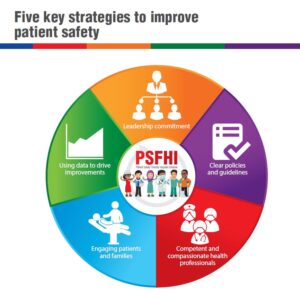Patient Safety Rights Charter of WHO.
Relevance
- GS Paper 2 Important International Institutions.
- GS Paper 3 Health.
- Tags: #World Patient Safety Day, #World Health Organization, #Patient’s Rights, #Patient’s Safety, #Charter of Patients’ Rights.
Why in the news?
On the occasion of World Patient Safety Day (17th September, 2023), the World Health Organization (WHO) released the first-ever Patient Safety Rights Charter, focusing on safeguarding patients in healthcare contexts.
- WHO advocates transitioning from a blame-oriented approach to a system-based perspective, focusing on understanding the underlying systemic errors in medical care.
- The theme for World Patient Safety Day 2023 is ‘Engaging patients for patient safety’.
Key facts
- Around 1 in every 10 patients is harmed in health care and more than 3 million deaths occur annually due to unsafe care. In low-to-middle income countries, as many as 4 in 100 people die from unsafe care.
- Above 50% of harm (1 in every 20 patients) is preventable; half of this harm is attributed to medications .
- Some estimates suggest that as many as 4 in 10 patients are harmed in primary and ambulatory settings, while up to 80% (23.6–85%) of this harm can be avoided.
- Common adverse events that may result in avoidable patient harm are medication errors, unsafe surgical procedures, health care-associated infections, diagnostic errors, patient falls, pressure ulcers, patient misidentification, unsafe blood transfusion and venous thromboembolism.
- Patient harm potentially reduces global economic growth by 0.7% a year. On a global scale, the indirect cost of harm amounts to trillions of US dollars each year.
- Investment in reducing patient harm can lead to significant financial savings, and more importantly better patient outcomes.
- An example of a good return on investment is patient engagement, which, if done well, can reduce the burden of harm by up to 15%.
Patient safety
Patient safety is the avoidance of unintended or unexpected harm to people during the provision of health care. Around 1 in every 10 patients is harmed in health care and more than 3 million deaths occur annually due to unsafe care, according to Organization for Economic Co-operation and Development (OECD). In low-to-middle income countries, as many as 4 in 100 people die from unsafe care.
According to the WHO some of the most common sources of patient harm are medication errors, System and organisational factors; technological factors; human factors and behaviour, surgical errors, health care-associated infections, sepsis, diagnostic errors and patient falls.
What are the Patient’s Rights?
- Patient rights are the core code of conduct between healthcare service providers, patients, and the hospital.
- A patient refers to an individual who requested a healthcare service or is under the guidance of a healthcare provider.
- Healthcare service providers include hospitals, clinics, healthcare professionals, medical insurance agencies, etc.
- In legal terms, a patient’s rights are a generalised statement covering access to medical facilities, the dignity of the patient, consent to treatment, and privacy, followed by healthcare institutions or medical caregivers.
Charter of Patients’ Rights
The Ministry of Health and Family Welfare circulated the country’s first Charter of Patients’ Rights in a letter to all state governments in June 2019. It was implemented as a remedy against the increasing complaints of inadequate medical care and medical malpractices.
Here are all of them
- Right to Information.
- Right to Records and Reports.
- Right to Emergency Medical Care.
- Right to Informed Consent.
- Right to Confidentiality, Dignity, and Privacy.
- Right to Second Opinion.
- Right to Transparency in Rates.
- Right to Non-Discrimination.
- Right to Safety and Quality Care According to Standards.
- Right to Choose Alternative Treatment Options if Available.
- Right to Choose Source for Obtaining Medicines or Tests.
- Right to Proper Referral and Transfer.
- Right to protection for patients involved in clinical trials.
Need for the Patient Safety Rights Charter
Disturbing Figures: Data from the Organisation for Economic Co-operation and Development (OECD) presents concerning statistics regarding patient safety.
-
- Approximately 1 in 10 patients experience harm while receiving healthcare.
- Over 3 million deaths occur annually due to unsafe healthcare practices.
- In low-to-middle income countries, as many as 4 in 100 deaths can be attributed to unsafe healthcare.
For Safety: Investments in patient safety have a positive impact on health outcomes, lead to cost reductions associated with patient harm, enhance the efficiency of healthcare systems, and contribute to rebuilding community trust in healthcare systems.
- The majority of patient harm incidents can be prevented, highlighting the crucial role of involving patients, families, and caregivers in minimizing harm.
Shift in Approach: The Patient Safety Rights Charter highlights the necessity of shifting from a blame-focused approach to a system-based perspective when addressing patient safety concerns.
Conclusion
The Patient’s Rights Bill is a great solution to fight discrepancies and malpractices in healthcare. Most importantly, not only the doctors and healthcare professionals are responsible, but also the hospitals take part in such unfair practices. Therefore, it is imperative to know the patient’s rights bill in detail. Not only the doctors but also all members of the inter-professional team should look after patients’ rights.
Source: WHO





